PAPER-CUTTING AS INTANGIBLE CULTURAL HERITAGE HISTORICAL PERSPECTIVES AND UNESCO RECOGNITION
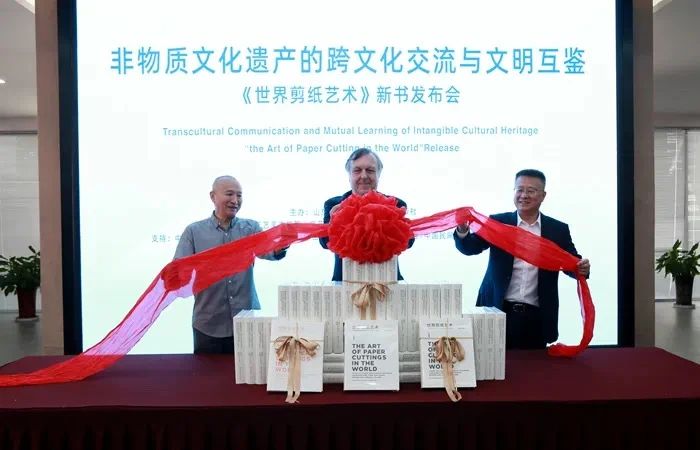

In the 19th century the Danish author Hans Christian Andersen, famous for his books like the Little Mermaid or the Ugly Duckling, Karl August Varnhagen von Ense and Rosa Maria Assing shared their love for paper cutting and immortalized this art form.
《小美人鱼》和《丑小鸭》等作品闻名于世的丹麦作家安徒生、卡尔·奥古斯特·瓦恩哈根·冯·恩斯和罗莎·玛丽亚·阿辛都分享了他们对剪纸的热爱,并使这种艺术形式永垂不朽。
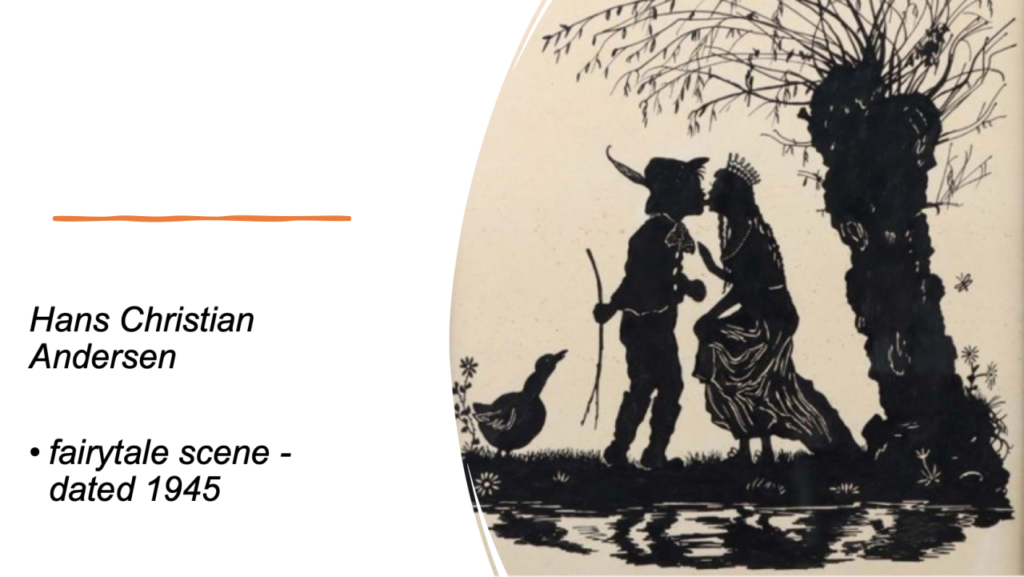
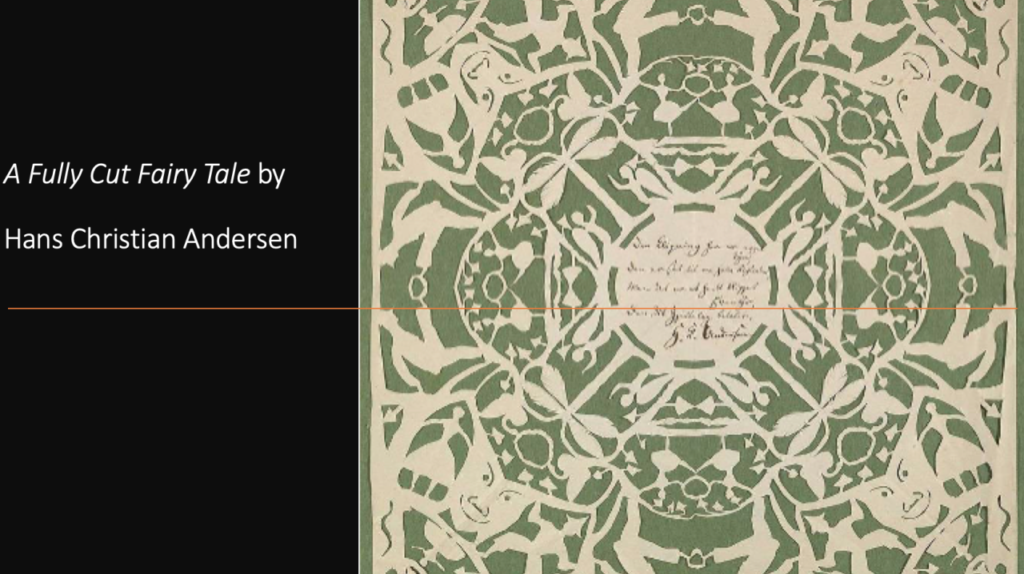
Hans Christian Andersen, for instance, used paper cutting to find a psychological belonging since family life was inaccessible for the Danish bachelor. He always carried a pair of big scissors wherever he traveled, Andersen amused children by cutting paper while telling fairy tales. As his large hands weaved through the delicate materials, the tales reached their climax. When opened, the patterns of the cut-outs were both surprising and lively. The dancing pierrots, ballerinas, oriental palaces, swans, trees, and fairies on Andersen’s paper cuttings are the inspirations for some of the author’s best fairytales. By using papers of various colors and expanding the subjects beyond human portraits, Andersen greatly influenced nineteenth-century European paper-cutting, where silhouettes of humans with black paper were the mainstream at that time. Andersen shared his love for paper cutting. In a letter in July 1867, where he wrote: “Paper cutting is the prelude to writing.” Many of his famous paper-cuttings are kept at the Andersen Museum in Denmark.
例如,安徒生利用剪纸来寻找心理归属感,因为对于丹麦单身汉来说,家庭生活是遥不可及的。无论走到哪里,安徒生总是随身带着一把大剪刀,一边讲童话故事,一边剪纸逗孩子们开心。当他的大手在精细的材料上穿梭时,故事也达到了高潮。当打开后,剪纸的图案令人惊讶而又生动活泼。安徒生剪纸上跳舞的皮埃罗、芭蕾舞演员、东方宫殿、天鹅、树木和仙女,都是作者一些优秀童话故事的灵感来源。安徒生使用各种颜色的纸张,并将主题扩展到人物肖像之外,这极大地影响了19世纪的欧洲剪纸,在当时,用黑色纸张剪出的人物剪影是主流。安徒生与人分享了他对剪纸的热爱。在1867年7月的一封信中,他写道:“剪纸是写作的序章”。他的许多著名剪纸作品都保存在丹麦的安徒生博物馆。
Other paper-cut artists transcended beyond their own inner psyche when creating cut-outs. As a patriot who was sympathetic to the Jewish population, Varnhagen chose great historical figures and events during the Napoleonic War as the subjects of his cut-outs. Hence, his “little art” creations were a portrait of Europe in the nineteenth century, with abundant historical and cultural references that are of paramount importance in historical research.
其他剪纸艺术家在创作剪纸作品时也触及了自己内心世界的最深处。作为一个同情犹太人的爱国者,瓦尔纳根(Varnhagen)选择了拿破仑战争期间的伟大历史人物和事件作为他剪纸作品的题材。因此,他的“小艺术”作品是十九世纪欧洲的写照,其中蕴含着丰富的历史和文化内涵,对历史研究具有至关重要的意义。
As shown, in Switzerland the folk art came to celebrate Swissness, admiration for order and reliability, family and community, daily and seasonal rituals, as well as nature, landscapes, and animals such as cows and goats. Papercut art as a celebration of Swiss nationality and culture had been achieved in ways that other nations seemingly were not able to do.
如图所示,在瑞士,民间艺术传达了对瑞士特质的赞美,对秩序和可靠性的推崇,对家庭和社区的重视,以及对日常和季节性仪式、自然、风景以及牛和山羊等动物的热爱。剪纸艺术作为对瑞士国籍和文化的庆祝载体,已经取得了其他国家似乎无法做到的成就。
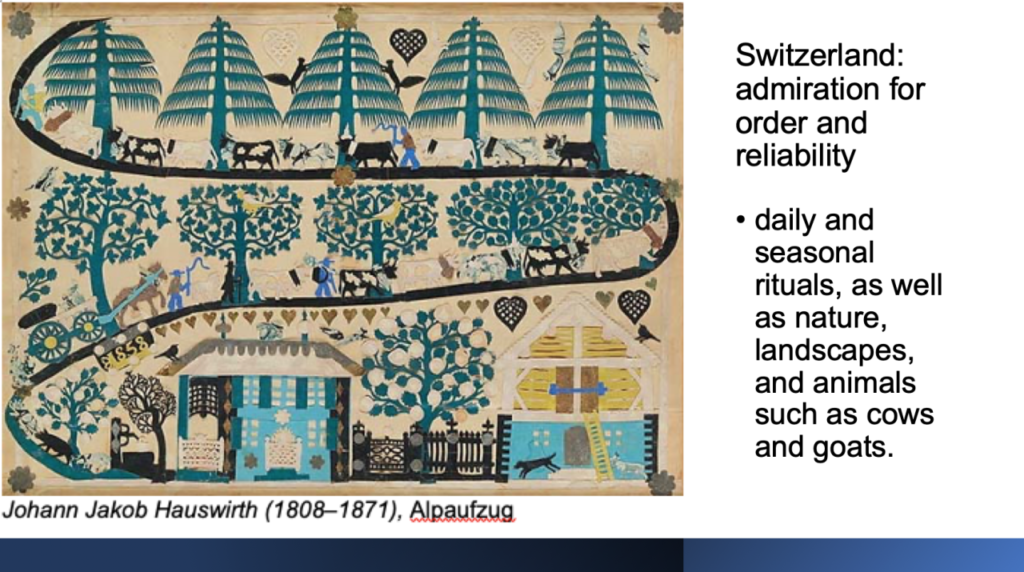
As we have noted, each tradition of paper-cutting has developed a unique style that sets it apart from others. The styles range from simple silhouettes to wonderfully intricate and colorful objects.
正如我们所注意到的,每一种剪纸传统都形成了独特的风格,使其与众不同。这些风格既有简单的剪影,也有精致复杂且色彩丰富的物件。
In Japan, the art of paper cutting is called kirie or Kirigami , which comes from the two kanji, kiri meaning cut, and gami絵 meaning picture. The art of making pictures through the cutting of paper is believed to have emerged in Japan in 610 A.D., after tesuki washipaper was invented in China, and imported by Doncho, a Buddhist monk from Korea.Originally, kirie was used to decorate Shinto shrines.
在日本,剪纸艺术被称为“kirie”或“Kirigami”,这两个词分别来自两个汉字,“kiri”是剪的意思,“gami絵”是画的意思。通过剪纸制作图画的艺术据说是公元610年在日本出现的,当时中国发明了德木和纸,韩国的佛教僧侣Doncho将其传入了日本。最初,剪纸被用来装饰神社。
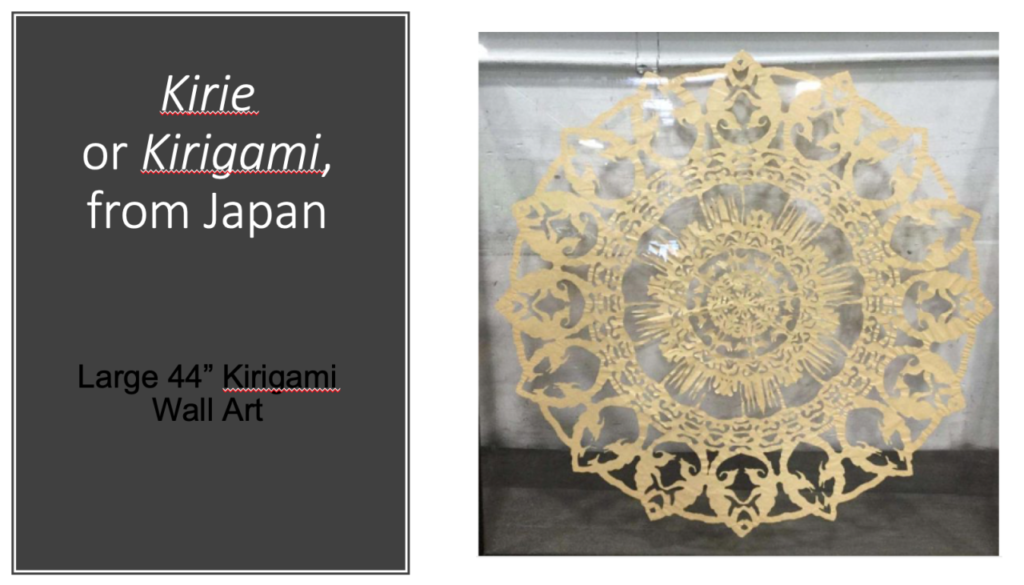
The Japanese commercialized paper-making by hand, and by 800 A.D. their skills were renowned. The abundance of Japanese washi meant paper-cutting and offshoots developed at a very fast pace. In the Edo Period, kamikiri (meaning paper-cutting) was performed live in front of an audience. Masters of the craft would take requests from the audience and transform sheets of paper into cut-outs right in front of their eyes.
日本人将手工造纸商业化,到了公元800年,他们的造纸技术已经闻名遐迩。日本和纸的丰富意味着剪纸及其衍生物的飞速发展。在江户时代,kamikiri(意为剪纸)是在观众面前现场表演的。工艺大师们会应观众的要求,在他们眼前将纸张变成剪纸作品。
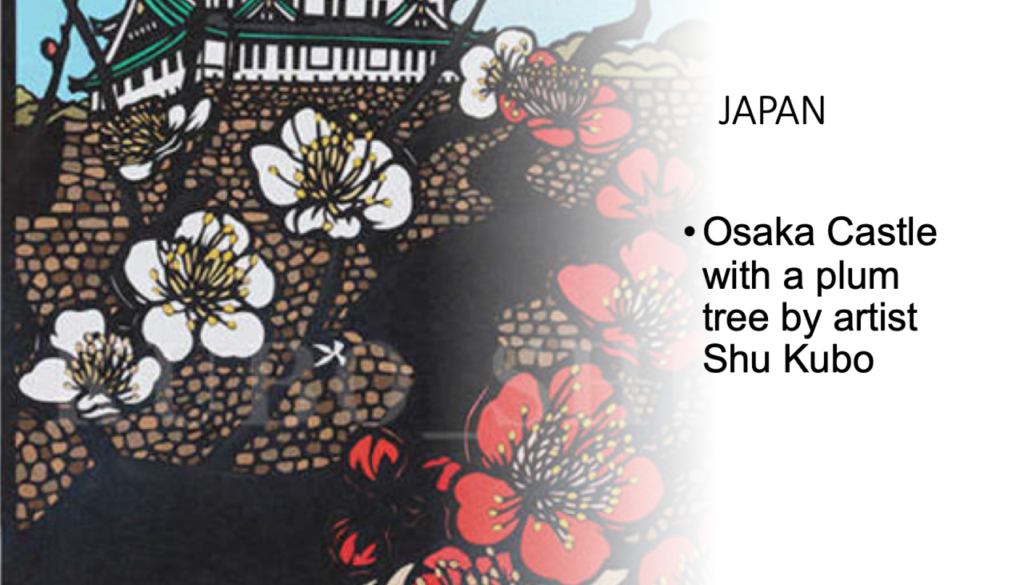
Today, the Japanese continue to practice art by paper-cut, particularly for framed art, installations and sculpture. Modern kirie has since developed into a contemporary art form for Japanese artists, who create intricate pieces of work that can take mere minutes, or as much as many months to complete. Some of the works are a feast for the eyes, such as Osaka Castle with a plum tree by artist Shu Kubo or the incredibly detailed octopus cut from a single sheet of A2 paper by artist Masayo Fukuda.
现如今,日本人仍在继续从事剪纸艺术,尤其是用于装裱艺术、装置艺术和雕塑。现代剪纸已发展成为日本艺术家的一种当代艺术形式,他们创作出精致的作品,可能只需几分钟,也可能需要花费数月才能完成。其中一些作品堪称视觉盛宴,如艺术家ShuKubo创作的带有梅树的大阪城,以及艺术家MasayoFukuda用一张A2纸剪出的精致无比的章鱼。
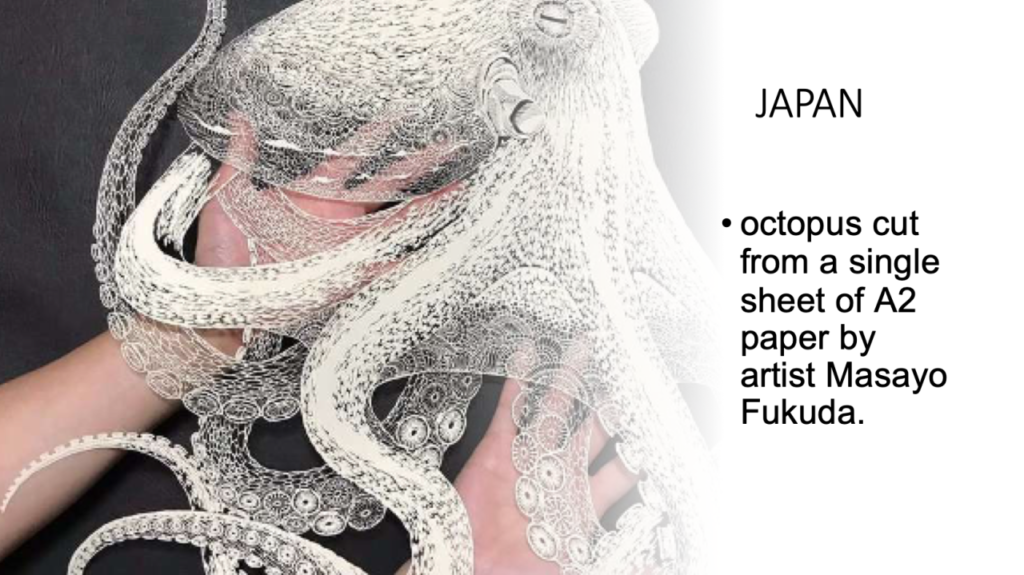
Nowadays, washi paper is most predominantly used worldwide for paper-cut art, as well as for book binding, tapes and multiple other uses. However, it is not tesuki washi but actually Japanese Sekishu washi, a paper developed around 800 A.D. in the Sekishu region (modern-day Iwami in Japan). As Chinese paper-cutting, it was also inscribed in 2009 in the UNESCO Representative List of Intangible Cultural Heritage of Humanity.
如今,和纸在世界范围内被广泛用于剪纸艺术,以及书籍装帧、胶带和其他多种用途。然而,它并不是德木和纸,而是日本的关州和纸,一种公元800年左右在关州地区(今日本石见)发展起来的纸张。作为中国的剪纸,它也于2009年被列入联合国教科文组织《人类非物质文化遗产代表作名录》。
In the Philippines, several crafts have incorporated the art of paper-cutting. For example, during Christmas celebrations a parol (a traditional star-shaped lantern), is embellished with colored paper cut into various forms such as floral designs in colored paper. Palabát (or “wrapper”) is another Filipino tradition that involves paper-cutting, where colored paper is cut with small scissors and used to wrap pastillas de leche (carabao milk candy) and other traditional candies. Banderitas, or bunting, is created by paper-cut art during holidays and fiestas. They are often hung on homes and over streets and take the shape of squares and triangles.
在菲律宾,许多手工艺品都融入了剪纸艺术。例如,在圣诞节庆祝活动中,人们会用彩纸剪成各种样式的图案(如花卉图案彩纸)来装饰parol(一种传统的星形灯笼)。Palabát(或称“包装纸”)是另一种菲律宾传统,涉及用小剪刀剪裁彩纸,用来包装pastillasdeleche(carabao奶糖)和其他传统糖果。Banderitas,即彩旗,是在节日期间用剪纸艺术制作的。它们通常被挂在家中或街道上,形状为正方形和三角形。
In Indonesia, traditional art has been influenced by traditional Chinese artisans. Batik is an Indonesian traditional art and paper-cutting.
在印度尼西亚,传统艺术受到中国传统工匠的影响。蜡染是印尼的一种传统艺术和剪纸艺术。
In India, Sanjhi is the ancient art of paper-stenciling originating from Mathura and Vrindavan. Sanjhi artisans first cut stencils out of paper, then filled with powdered dyes to create rangolis, an integral part of Indian culture. Often, the designs are inspired by nature and range from trees to animals, such as peacocks and cows. Traditionally, the stencils are used to create rangolis on water, also known as Jal Sanjhi. Using a fine sieve, colored powder is slowly added, layer by layer onto paper stencils to create paintings that float on a vessel of water. These paintings usually have religious meanings and are created during festive periods.
在印度,桑吉(Sanjhi)是源自马图拉(Mathura)和温达文(Vrindavan)的古老纸模板艺术。桑吉艺术工匠首先在纸上剪出模板,然后填入染料粉末,创作出印度文化不可或缺的一部分–蓝果丽(rangolis)。设计灵感通常来自于大自然,从树木到动物,如孔雀和奶牛。传统上,模板用于在水上制作蓝果丽,也称为水中纸刻(JalSanjhi)。通过使用细筛,彩色粉末逐层添加到纸板模板上,创作出漂浮在水容器上的绘画。这些画通常具有宗教含义,在节日期间由人们创作。
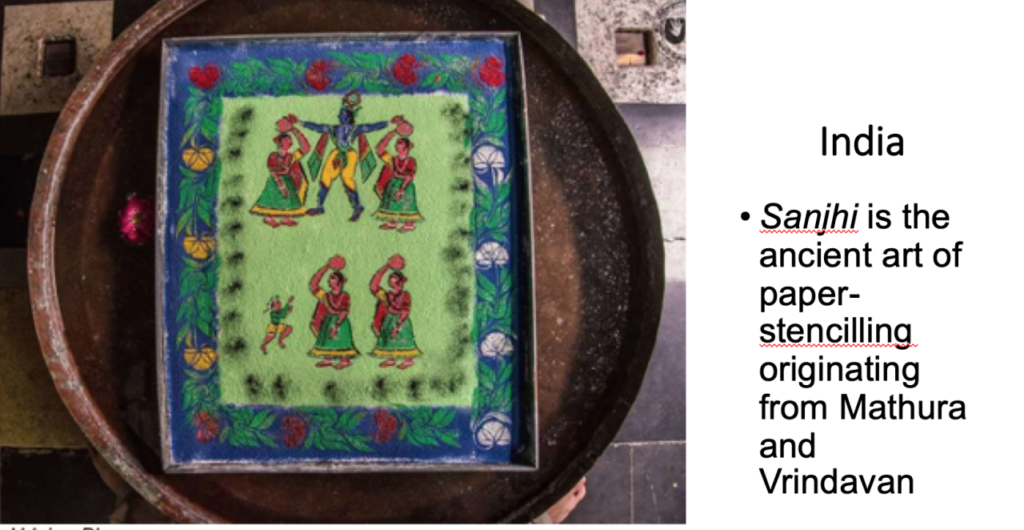
Paper-cutting also has had a long and popular history in Mexico, with the craft originating with the Mayans in the 6th century. The Aztec people used mulberry and fig tree bark to create rough paper. Paper-cutting is called papel picado. San Salvador Huixcolotla, a town not far from Mexico City, is considered to be the birthplace of papel picado. There, artisans began carving out by hand, using scissors or sharp chisels, intricate banner designs on tissue paper. Individual flags of varied shapes and sizes, in a huge array of vibrant colors, are cut from tissue paper or plastic (the modern alternative for increased durability). The flags are then strung together to form banners that can be used for just about any occasion – street parties, birthdays, weddings -, especially also during Día de Muertos, or Day of the Dead, a widely celebrated Mexican holiday, Christmas, or Easter. This practice eventually spread to the rest of Mexico in the 20th century.
剪纸在墨西哥也有悠久而流行的历史,这种工艺起源于6世纪的玛雅人。阿兹台克人使用桑树和无花果树皮制作粗糙的纸张。剪纸被称为“papelpicado”。圣萨尔瓦多·韦斯科洛特拉(SanSalvadorHuixcolotla)是墨西哥市附近的一个城镇,被认为是papelpicado的发源地。在那里,工匠们开始用剪刀或锋利的凿子在纸巾上手工雕刻出复杂的标语设计。用纸巾或塑料(现代的替代品,更耐用)剪出形状和大小各异、色彩鲜艳的单个标志。然后将这些标志串联起来,形成横幅,可用于任何场合–街头聚会、生日、婚礼–尤其是在亡灵节(DíadeMuertos,即亡灵日,墨西哥人广泛庆祝的节日)、圣诞节或复活节期间。这种习俗最终在20世纪传到了墨西哥其他地区。
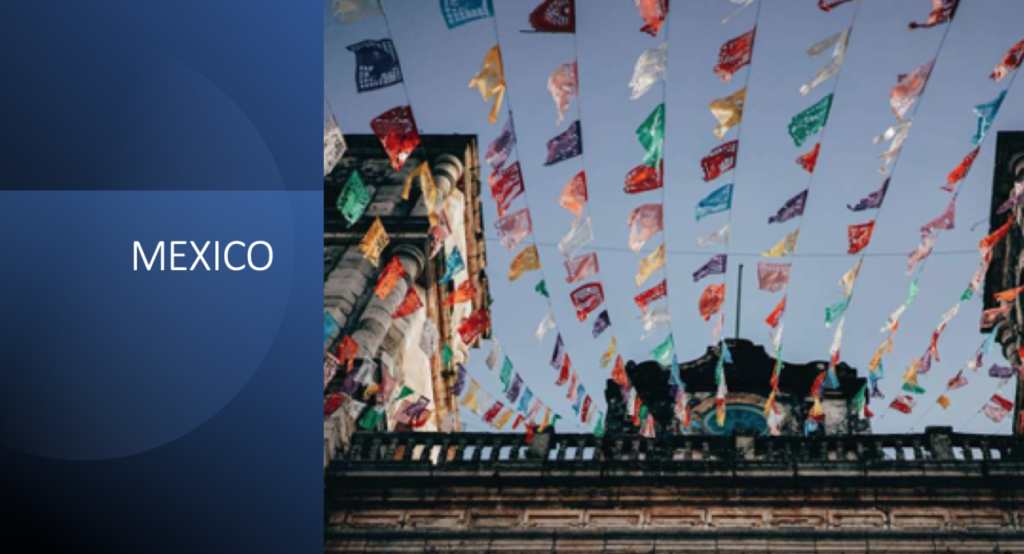
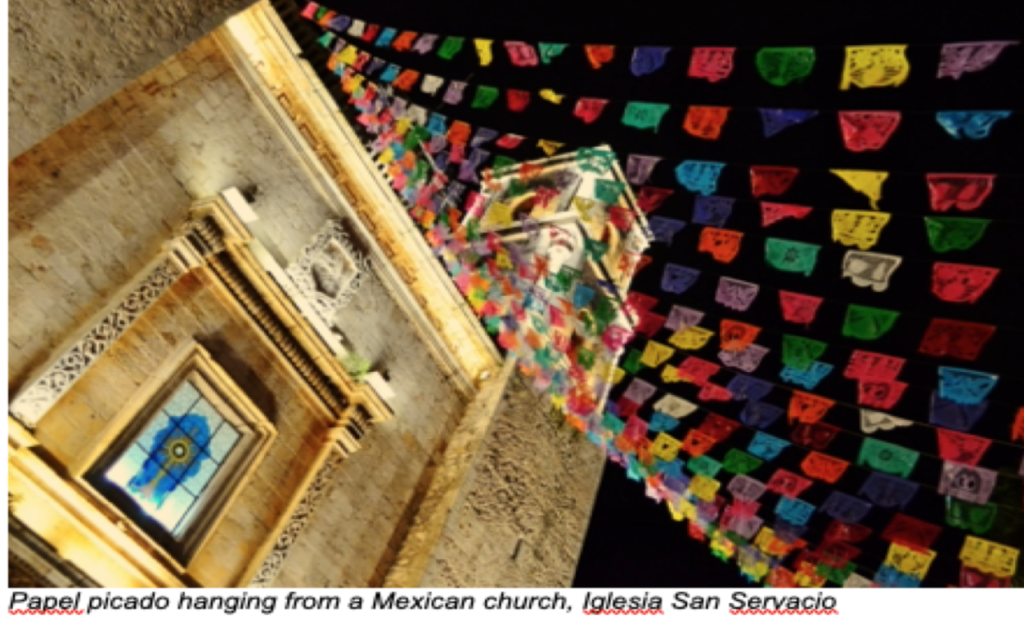
A Slavic version of the art form of paper-cutting, popular in Poland, Belarus, and Ukraine, is called Wycinanki ([vɨt͡ɕiˈnaŋkʲi] (pronounced vee-chee-non-kee) in Poland or Vytynanky (Витина́нки) in Ukraine or Vycinanki (Выцінанкі) in Belarus. Roosters, flowers, and holiday motifs are frequently the subject matter of bright and multilayered artworks.
在波兰、白俄罗斯和乌克兰等斯拉夫国家中,剪纸艺术也很流行,在波兰被称为Wycinanki(发音为vee-chee-non-kee),在乌克兰被称为Vytynanky(Витинанки),在白俄罗斯被称为Vycinanki(Выцінанкі)。公鸡、花朵和节日图案经常是明亮而多层次艺术作品的主题。
In Poland of the 1800s, shepherds passed quiet hours by snipping designs from leather or tree bark. Since the mid-1800s, wycinanki has been a popular folk craft and was traditionally used by Polish peasants to decorate their cottages. The Polish paper-cutting art is mostly separated into two regions. Cuttings from the Kurpie region are often symmetrical and intricate, usually of a single color. Those from Łowicz in central Poland, however, are multi-colored and achieved by layering multiple pieces of cuttings together. They often depict peacocks, roosters, and other birds, as well as a variety of rural scenes.
在19世纪的波兰,牧羊人通过在皮革或树皮上剪下图案来打发宁静的时光。自19世纪中期以来,wycinanki一直是一种流行的民间手工艺品,传统上被波兰农民用来装饰他们的小屋。波兰的剪纸艺术主要分为两个地区。库尔皮地区的剪纸通常是对称和复杂的,且通常是单色的。而波兰中部罗维奇地区的剪纸则是多色的,通过将多幅剪纸叠加在一起来实现。它们通常会描绘孔雀、公鸡和其他鸟类,以及各种乡村场景。

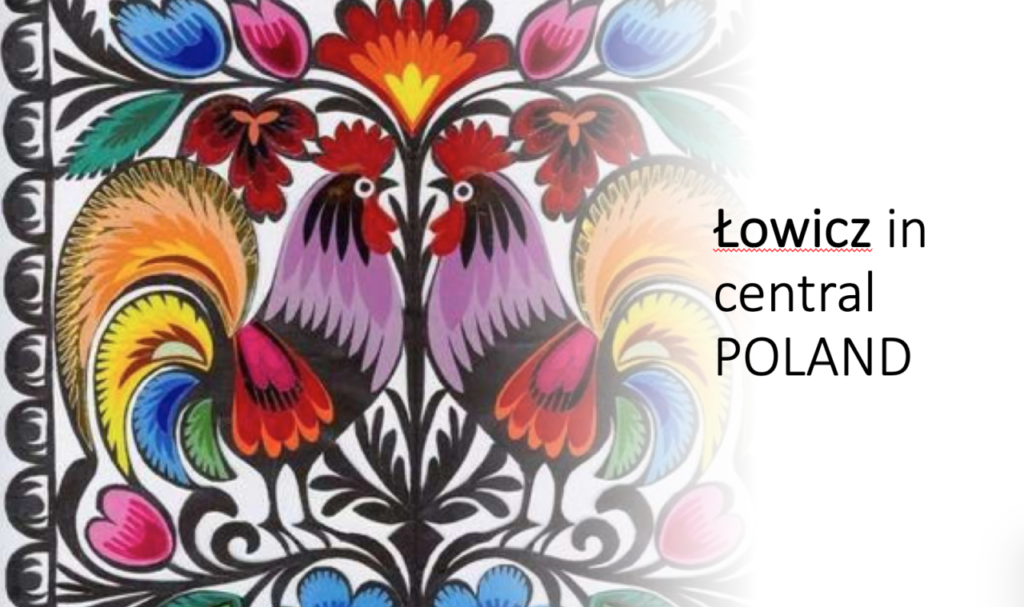
Nowadays, contemporary paper-cutting is more commonly practiced and is considered fine art, with works of incredibly skilled paper cutting artists showcased in galleries around the world.
如今,当代剪纸艺术更为普遍,被人们视为精美艺术,许多技艺高超的剪纸艺术家的作品被展示在世界各地的美术馆中。
One of the most sophisticated form of paper-cutting is being displayed in a museum in the city of Mollerussa near Barcelona, Spain. This museum exhibits nearly 500 paper-made dresses of various periods adorned by flowers, jewellery, sophisticated broderies, shoes, earrings, snakes, claws, feathers, leaves, bags, crowns, and many other complements all made from paper, requiring years of works and artistry. The most used papers are paper-mâché, silk paper, crepe paper, toilet paper, chocolates wrapping paper and others. Expertise, patience and skills are required to obtain thread or twisted paper for making crochet and chain stitches to use for macramé, The Mollerussa museum displays designs from fashion masters like Peter Aedo, Lydia Delgado, Oscar de la Renta, Agatha Ruiz de la Prada, Victorio&Lucchino, Armand Bassi, Jordi Labanda, Konrad Muhr, Lorenzo Caprile, Rosa Clarà and Toni Francesc, all transformed into paper fabrics.
在邻近西班牙巴塞罗那的莫勒鲁萨市的一家博物馆里,就展出了其中一种最精致的剪纸作品。这座博物馆展出了近500件不同时期的纸制服饰,上面装饰着鲜花、珠宝、精致的锦缎、鞋子、耳环、蛇、爪子、羽毛、树叶、袋子、皇冠和许多其他装饰品,所有这些都是用纸制作的,需要数年时间的工作和一定的艺术造诣。最常用的纸张是纸浆纸、丝纸、绉纸、卫生纸、巧克力包装纸等。莫勒鲁萨博物馆展示了彼得·埃多(PeterAedo)、莉迪亚·德尔加多(LydiaDelgado)、奥斯卡·德拉伦塔(OscardelaRenta)、阿加莎·鲁伊斯·德拉·普拉达(AgathaRuizdelaPrada)、维克多里奥·卢奇诺(Victorio&Luc-chino)、阿曼德·巴斯(ArmandBassi)、约尔迪·拉班达(JordiLabanda)、康拉德·穆尔(KonradMuhr)、洛伦佐·卡普里莱(LorenzoCaprile)、罗莎·克拉拉(RosaClarà)和托尼·弗朗西斯克(ToniFrancesc)等时尚大师的设计作品,这些作品都被转化成了纸织物。
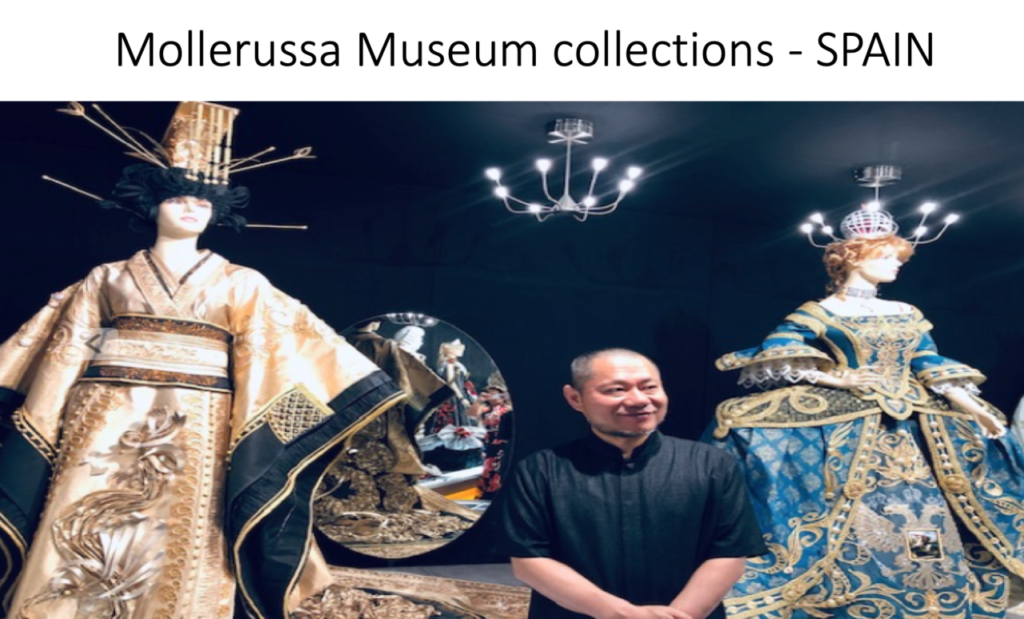
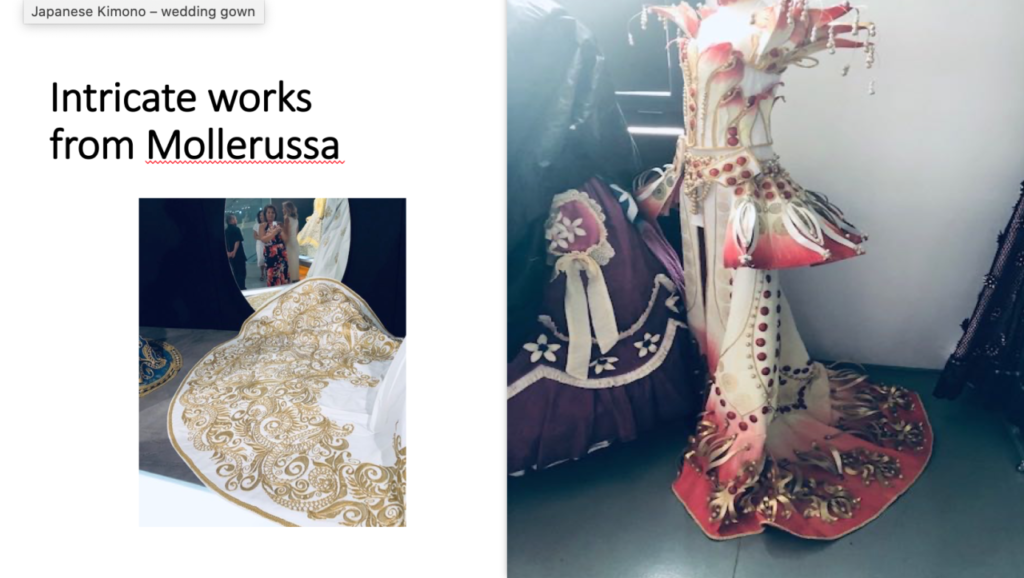
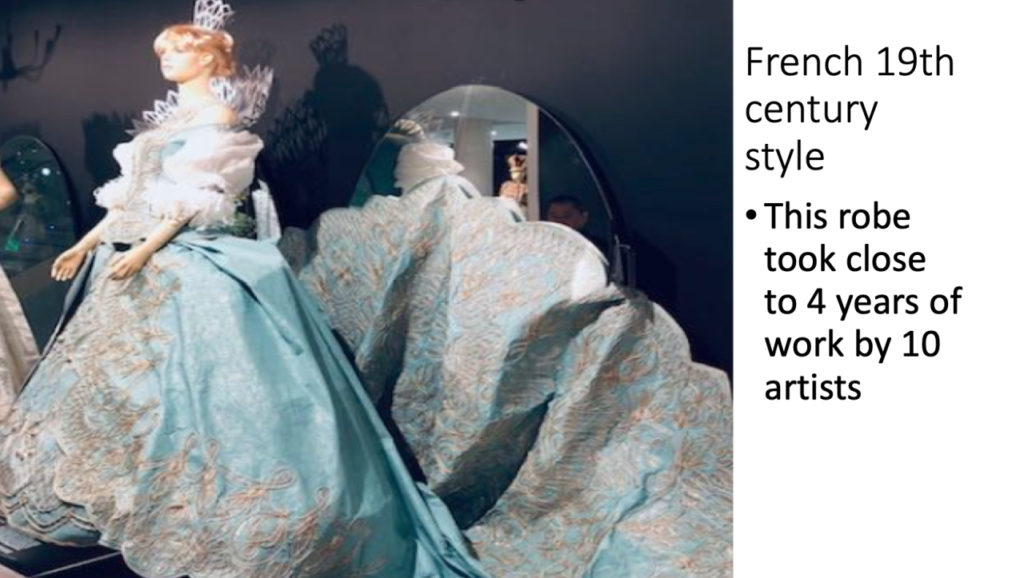
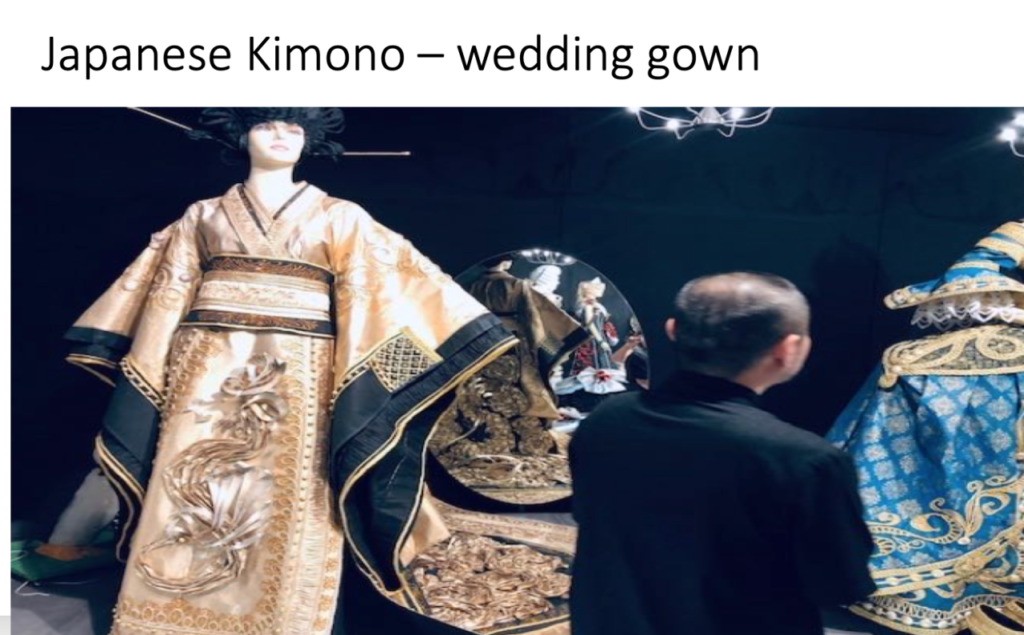
Contemporary paper-cutting is more commonly practiced and is considered fine art, with works of incredibly skilled paper-cutting artists showcased in galleries around the world. Take as an example the paper micro-organisms of Anglo-Irish artist Rogan Brown. Using both hand and laser-cut incisions, his impressive attention to detail creates eye-opening works of art. It is hard to believe that they are made from paper.
当代剪纸艺术已更为普遍,被人们视为精美艺术,许多技艺高超的剪纸艺术家的作品被展示在世界各地的美术馆中。以英裔爱尔兰艺术家罗根·布朗(RoganBrown)的纸质微生物为例。他运用手工和激光切割技术,通过其令人瞩目的细节关注力创造了震撼人心的艺术作品。很难相信它们是用纸做成的。
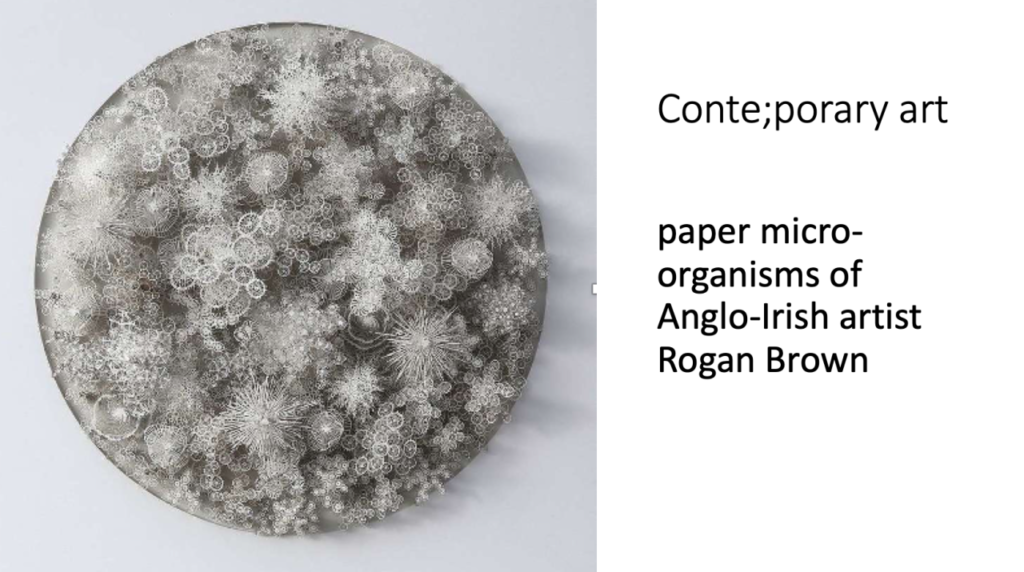
Other famous artists working with and excelling in cuts are the silhouette works from black paper by Kara Walker (United States) and William Kentridge (South Africa) – both of whom also created room-size works.
此外,以剪纸为材料并擅长切割的知名艺术家还有用黑纸创作的剪影作品的卡拉·沃克(KaraWalker,美国)和威廉·肯特里奇(WilliamKentridge,南非),–这两位艺术家也都创作过房间大小的作品。
In the words of Kara Walker: “What the cyclorama and the silhouette have in common is that they’re complete opposites, but they’re sort of not relegated to art. … [The cyclorama creates] an illusion of space, whereas the silhouette, of course, flattens out space and identity.”
用卡拉·沃克的话说:“环景画和剪影的共同之处在于,它们是完全对立的,但又不属于艺术范畴。……[环景画]创造了一种空间错觉,而剪影自然就是将空间和特性扁平化”。
Where the early silhouette portraitists saw cut paper as a way to capture a person’s likeness, Kara Walker perceived an opportunity for caricature, and a metaphor for shallow stereotypes, simplification, and frozen points of view. Walker started as a painter and has utilized a huge variety of media in her work.
早期的剪影肖像画家认为剪纸是捕捉人物肖像的一种方式,而卡拉·沃克则认为剪纸是一种进行夸张讽刺描绘的机会,是对肤浅的刻板印象、简化和凝固的观点的一种隐喻。沃克最初是一名画家,她的作品利用了多种媒介。
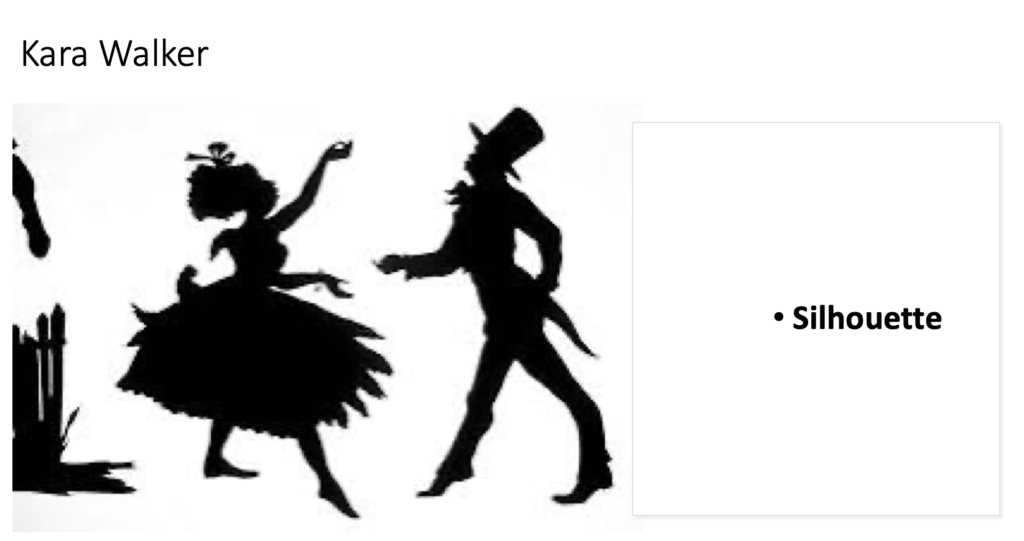
Cut-outs were also the final chapter in Henri Matisse’s career. Matisse painted the paper first, then cut it out with scissors. Some of his world-famous works were room-sized — like the Swimming Pool.
剪纸也是亨利·马蒂斯职业生涯的最后一章。马蒂斯先在纸上画画,然后用剪刀剪下来。他的一些举世闻名的作品有房间那么大,比如《游泳池》。
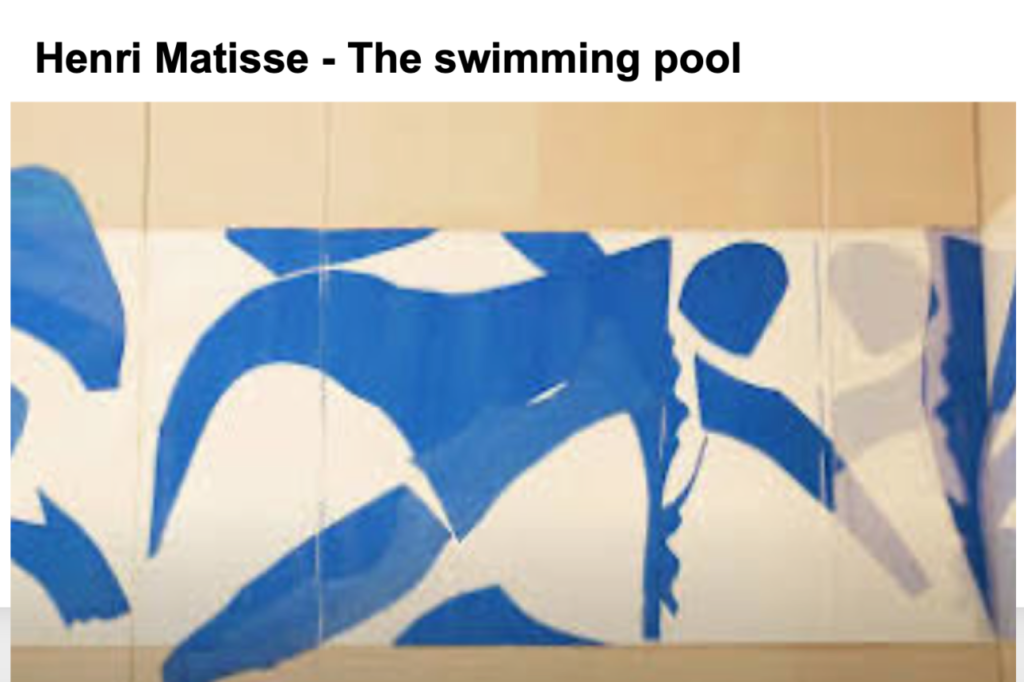
The Chinese artist Jennifer Wen Ma also has worked since several years with cut-outs of paper and other materials, which were recently displayed in the MGM Grand Hotel in Macao.
中国艺术家马文(Jennifer)多年来也一直在使用剪纸和其他材料进行创作,最近在澳门的美高梅大酒店展出了她的作品。
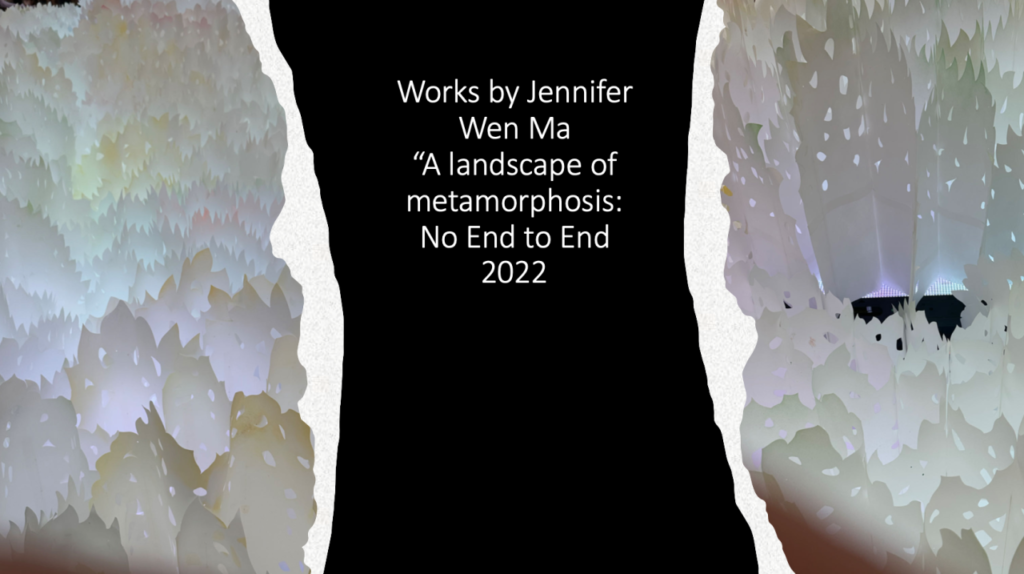
In conclusion, paper-cutting art started in early centuries in Chinese civilizations and has travelled, if not penetrated the world. In the process, it has become part of centuries of human fascinations with tangible and intangible art, culture and heritage. As it was ultimately inscribed into the global and multilateral annals of UNESCO, it became part of a compendium of historical works and tools of humanity, recognized and honored by the almost 200 Member States of the United Nations and its specialized agency UNESCO, recognized as a unique and precious element of humanity’s cultural diversity and heritage.
总而言之,剪纸艺术起源于中华文明的早期世纪,如今,不说完全渗透,至少已经传遍了全球。在这一过程中,剪纸艺术成为人类数百年来对有形和无形艺术、文化和遗产痴迷的一部分。它最终被载入教科文组织的全球和多边史册,成为人类历史作品和工具汇编的一部分,得到联合国及其专门机构教科文组织近200个会员国的认可和尊重,成为了人类文化多样性和遗产中的独特和宝贵的元素之一。
February 2015 in Doha, Qatar
2015年2月,卡塔尔多哈
Presentation by
Mehri Madarshahi
Shandong University of Arts and Design
Jinan, 15 May 2024
梅里·马达沙希
山东工艺美术学院
济南,2024年5月15日
(以上图片由梅里·马达沙希女士提供)

